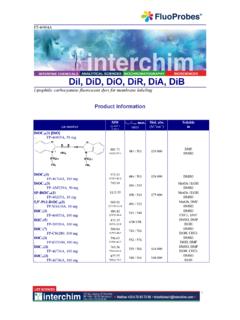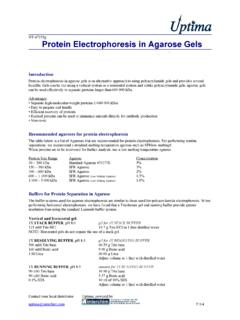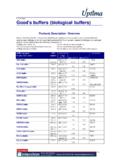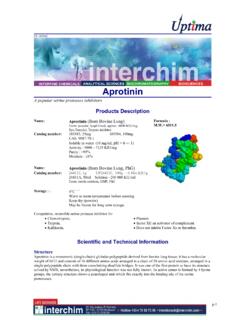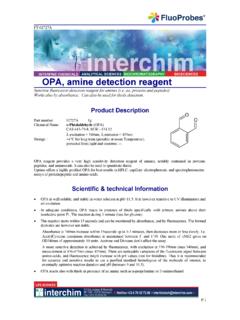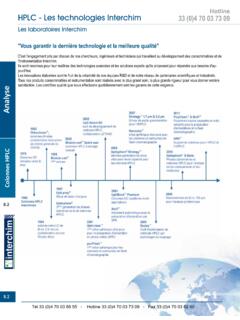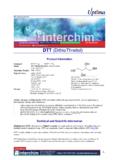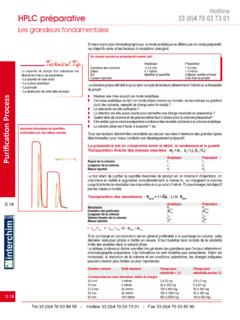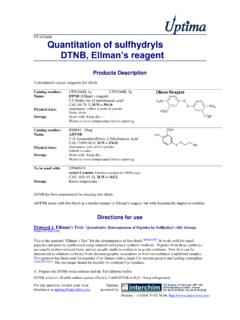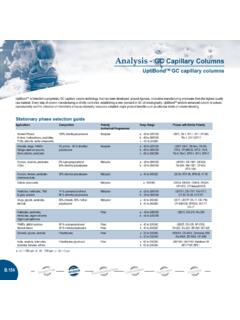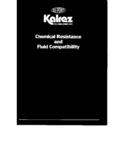Transcription of Buffering agents and Buffers - INTERCHIM: Home
1 P09E Buffering agents and Buffers This document includes: Solvents Water | DMSO, DMF [solubilisation] More Solvents Buffering agents , and their formulated Buffers Borate | Carbonate | Citrate | Glycine | Tris | Phosphate | .. More classic Buffering agents (mineral and organic Buffers ) Hepes | ACES | CAPSO| MES | MOPS,.. More Good's Buffers and other biological Buffers Additives for buffer solutions preparation Formulated Buffers by techniques [electrophoresis/blotting, affinity chromatography, cell culture and assay, immunodetection,..] Introduction to Buffers (solvents, Buffering , additives) Most applications in biotechnologies and biochemistry of proteins operate in aqueous solutions. Other more or less polar solvents are however useful, and apolar organic solvents are used to solubilize reagents in typically in biochemistry. Water is determinant to interactions of biological systems, dissociating in H+ and OH- ions thus interfering with ions and charged biomolecules, but also interacting by Van de Wahl binding to solvate biomolecules and by hydrophobic interactions to form micelles or precipitates.
2 Organic solvents may be helpful to solubilize hydrophobic compounds prior mixing to aqueous Buffers . To that point, Buffers are aqueous solutions containing partly neutralized weak acids or bases that show little change in pH [H+ concentration] whatever ions are added. Requirements should be considered for the choice of the buffer , and it s use in each application. the pH should be determined at the final temperature, in presence of salts [ phosphate pH change with salts concentration] near the pKa of the Buffering compound. The Buffering compound should not absorb at wavelengths [ at 240-270nm for mass spectrometry].. Classic used Buffering agents are mineral Buffers [Phosphate, Tris, Borate, Citrate, ], but also several organic Buffers [Glycine, DEA,..]. Many requirements should be met [ Buffering range, solubility, compatibility with spectrometric or immunometric or cell assays.]
3 ] and several other points considered such as habits, availability and price. As a result, standard buffer , and even any choosen buffer are often not ideal at one point or the other, and one might take benefits from more specific and new Buffers . Biological Buffers differ from classic mineral ones to several points: they have pKa values closer to physiological pH [between 6 and 8]. These Buffers are not toxic to cells, and are not absorbed through cell membranes. The concentration, temperature, and ionic composition of the medium has minimal effect on the Buffering capacity. They are resistant to enzymatic and non-enzymatic degradation, furthermore they are essentially transparent to visible and ultraviolet light. For solubilizing, many reagents require a more polar [ Ethanol] or apolar solvent [DMSO, DMF]. In biochemistry and chromatography applications, organic solvents are used to create more or less or gradient of polarity [Acetonitrile, Propanol.
4 ] while acidic or alkaline substances are require to create desired pH [Citric acid, TFA,..]. As several most are nocive and even toxic, requiring often specific operating conditions, on should consider Green Substitutes or Alternatives[][]. Examples include limonene, (xylene->) histochoice, .. In each applications, many substances can be needed for various purposes: additives include preservatives, Antibiotics, Bacteriostatics , Protease or phosphatase inhibitors, compounds to block undesired reactions, detergents, saturating agents , chelatants, stabilisants, reducers,.. Our Buffers are offered in a variety of technical quality grades Interchim provides high quality biochemicals for use in Biotech, Purification, Molecular Biology, and Cell Culture. See General use Biochemicals (PH (alphabetic list, and other biochemical types: Buffers , salts, detergents, antibiotics, protease inhibitors.))
5 See also on line search [all Interchim supply] BC002b Solvents *Water and polar solvants Water Nuclease free, Sterile, RNase-Free Solution 457420, 500 ml . Ethanol EO7550, *Organic solvants DMSO, ACS grade 36765A, 500ml . DMF 12137K, 1L See Green Substitutes and Alternatives() See also solvents for chromatography, purification,.. [ TEA, TFA,..] Technical tip Solvents types One distinguishes 2 major types of solvents base on the polarity/hydrophilicity, because this affect greatly the solubility of compounds and the molecular interactions. Polar solvants are typically water and other hydrophilic molecules "aqueous solvants", mineral such as , or organic such as ethanol. They are used in large areas, because water and water-soluble compounds are ubiquitous in biosciences, as organisms, tissues, cells, biomolecule and notably proteins need a polar environment to maintain their structure.
6 Apolar solvants are typically components of petrol (obtained by fractionated condensation), having more or less long carbonated saturated chains, hence commonly called "organic solvants" (even organic solvent can be polar! This denomination is somewhat also paradoxal regarding low compatibility with organic systems-see below). Solvents with short chains and small MW are very volatile, and mostly used in chemistry to dissolve chemicals, often apolar, or to achieve high concentrations, but also in biochemistry, and even at low concentration in biotechnology (above a certain concentration, biomolecules denaturate often irreversibly-. protein tolerate depending on their nature). For similar reasons, organic solvents are also often nocive, because they dissolve in lipidic biological structures, desorganizing them. Even very low concentrations (ppm) can concentrate in cell membranes.
7 As a result, most organic solvents are toxic, with major targets such as neural cells (neurological disorders). Their a rising need of less or not toxic alternatives to organic solvants, notably in industry and chemistry. Buffers (salts, solutions, and formulated Buffers ) See also Buffers by applications: Immunodetection: Buffers [], Saturating agents [], Enzymatic substrates[] Biochemistry: Buffers for electrophoresis[], .. Cell Culture: Cell culture media components buffer descriptions are by alphabetic order of Buffering agents [list of powder, salts, formulated Buffers , solution, concentrates,..]: Borate pKa1[25 C]= | pH range Borate buffered saline should not be used in gel electrophoresis in the presence of polyols, including carbohydrates and their derivatives with which they make chelate complexes and give a bent zone with lateral spreadingr. Borate Buffers also have a high bacteriocidal effect.
8 Boric Acid UP070440, 1 kg pKa1 - , pKa2 - , pKa3 - , pH range: Boric Acid Proteomics Grade 10853A, 500 g 10853B 1 Kg Carbonate [all] Tech Sheet Ammonium Carbonate N1237A, 500 g - MW: ; CAS : 506-87-6 BC002b Calcium Carbonate 629245, 100 g 629246, 500g - MW: -; CAS : 471-34-1 Sodium Carbonate, Anhydrous, ACS grade 141321, 1 Kg 141322, (141321) MW: ; CAS : 497-19-8 Sodium Carbonate, Anhydrous, Reagent Grade 08499A, 1 Kg - MW: ; CAS : Carbonate Buffered solution Sodium Bicarbonate-Sodium Carbonate buffer , pH UPR16490, 250 ml - Applications: coating protein oon microplates Citrate [all] Tech Sheet pKa1= [pH ], pKa2= [pH ], pKa3= [pH ] | working global pH range Citrate is used notably for elution in affinity chromatography, but also for cell media. Citric Acid UP168781, 1 Kg Citric Acid ACS grade/ Biotech grade 673410, 500 g Citric Acid, Trisodium Dihydrate 218830, 1 Kg 218831, Kg Citric Acid, Trisodium Dihydrate Proteomics Grade 10853A, 500 g 10853B, 1 Kg Citric Acid, Ammonium Salt, Dibasic, UltraPure N12630, 500 g N12631, 1 Kg Glycine [all] Tech Sheet pKa1 - [pH range: ], pKa2 - [pH range: ] | pH range: Glycine is used in Buffers notably for elution in affinity chromatography, in electrophoresis Buffers , but also as quenching agent biochemistry.
9 Glycine UP018225, 1Kg ; CAS: 56-40-6 TG buffer (Tris/Glycine) see Tris Buffers TG-SDS buffer (Tris/Glycine/SDS) see Tris Buffers Phosphate buffer , and formulated Phosphate Buffers Phosphate Buffered solutions, and notably saline ones [PBS] are widely used, to dilute and incubate or wash reagents in immunodetection techniques, for cells in cell culture et cell assays, in Biochemistry notably with Phosphate buffer should not be used in assays where competition for phosphate groups, or complex formation with a metal ion is essential for the enzyme activation. Phosphate ions will inhibit carboxypeptidase, carboxylase, urease, muscle diaminase, formase and phosphoglucomutase. Classic used additives, depending on applications requirements, include -protease inhibitors, antibiotics,.. to prevent biomolecules degradation (in biochemistry, purification, storage) -detergents and saturating agents to prevent non specific binding.
10 (in Immunodetections) -Other inorganic ions are added for cell culture applications (see below Balanced salt solution/Dulbecco) Phosphate salts [all] Tech Sheet Ammonium Phosphate Dibasic 52195B, 1 Kg - BC002b MW: ; CAS : 7783-28-0 potassium Phosphate Dibasic, Anhydrous 687960, 500 g 687962, - MW: ; CAS : potassium Phosphate Monobasic 684481, 500 g 684482, 1kg 684483, (684481) MW: ; CAS : 7758-11-4 potassium Phosphate Tribasic QR5464, 500 g - MW: ; CAS : 7778-53-2 Sodium Phosphate Dibasic, Heptahydrate 836655, 50 g 836657, 1 Kg - MW: ; CAS :7782-85-6 BC002b Phosphate Buffered solution (PBS) Phosphate Buffered solution (PBS) is 137mM Sodium Chloride, 10mM phosphate, potassium Chloride; pH is It is a Phosphate Balanced Saline solution used in many Buffers and media, in biochemistry, proteomics and genomics, cell culture. Modified PBS formulation may vary potassium or add other as in DPBS or other BSS Buffers .
